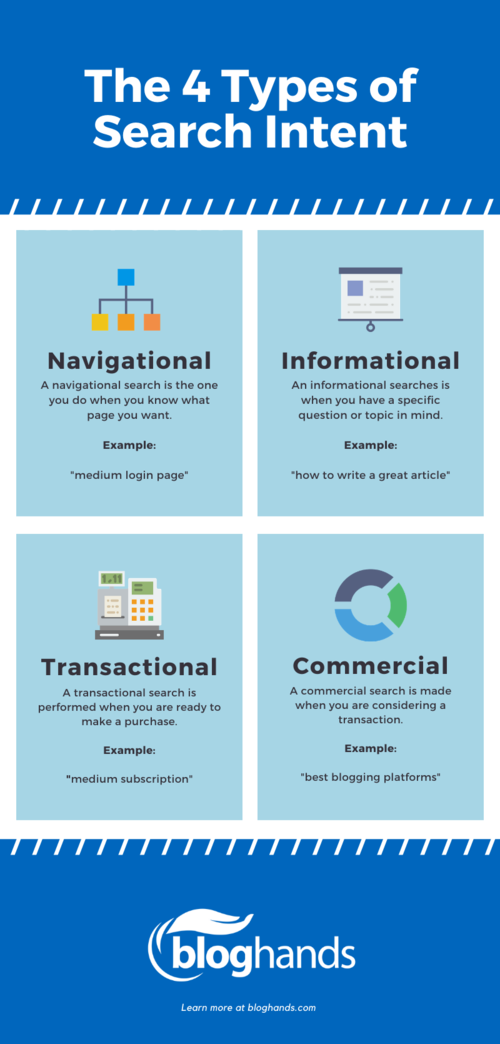Why and How to Optimize Content for Search Intent
What is Search Intent?
Search intent is the ultimate goal of the person searching for content. A search for running shoes may seem a simple enough request at first glance, but the intent behind the search could vary. Is this a potential customer looking to buy a pair of running shoes today in their neighborhood? Or does he want a brand comparison? Does she want to know what makes a shoe a running shoe?
If you understand not only what search terms your visitors are using but also why they use them, you can optimize your content for their intent. This means that your site will be more valuable. As a result, your business will be more useful, your visitors will get more of the content they want, and search engines will be more likely to serve your content to their users.
By the time you finish reading this post, you’ll understand the different types of search intent. And we’ll give you advice on the key ways to optimize your content for search intent. Read on to attract more visitors and serve them better.
What Are the Types of Search Intent?
We can categorize the vast majority of search terms as navigational, informational, commercial, or transactional. Check out the examples below and you’ll see that you can normally work out search intent by looking at the keywords. When it gets tricky, Google’s AI helps, because Google displays results differently according to search intent. Informational searches, for example, are less likely to feature ads than transactional or commercial searches.
Branding
Navigational – A navigational search is the one you do when you know what page you want, but you want a streamlined way to get to the URL. Whether for convenience or because searchers are not sure of the exact URL, they use a search engine to find the page.
An example of a navigational search, therefore, would be “Twitter Login,” “Bank of America contact,” or “Al Jazeera News.” Gaining search visitors with this intent means building a strong recognizable brand.
Marketing
Informational – searches with informational intent make up a massive 80 percent of all searches. Since so many people are seeking information, having a content marketing strategy is essential.
People performing informational searches have a specific question or want to know more about a certain topic. They frequently begin with the word “how.” Or they might look like “Best holiday destinations on a budget” or “productivity life hacks.”
This is where high-quality blog content comes into play. With high-quality evergreen pillar pages, you can keep attracting organic traffic, generating leads, engagement, and shares.
Sales
Transactional - This is where your product/service and other foundational content comes into play. To meet the demand of searches with transactional intent, provide your visitors with all the information they need to make a decision and complete a transaction.
This is a great kind of visitor! Unfortunately, many businesses create websites that are not expecting transactional search intent. They fail to help their visitors answer their questions, make decisions, or complete purchases.
Can you spot that these searches have a transactional intent?
Insurance quotes
International courier service
Flower delivery
Commercial - If a search has commercial intent, you might say that the visitor is considering a transaction but is not ready to make a purchase. They are weighing the pros and cons. They want more information before choosing a particular brand or solution.
Commercial and transactional intents, therefore, are similar, but appreciating the difference in the readiness of the searcher will help you create content that inspires them to act. This will improve the experience of your visitors and your bounce rate. Google will love you and is likely to send more organic traffic your way.
You can get very granular with search intent, particularly in the murky area between transactional and commercial intent. Consider a keyword or phrase that applies to your business. If you are unsure whether it has transactional or commercial intent, you can get clues by looking at the SERP.
Say you type “laptop cooler” into Google. The search engine will return sponsored shopping links very prominently at the top of the page. Hence, transactional intent. Beneath these are more shopping links followed eventually by pages more geared towards a commercial intent, comparing and contrasting products to help visitors make decisions. According to Google’s data, this is what people want when they use that keyword. If you want to rank for “laptop cooler,” creating a post for informational intent is probably not the way to go.
Benefits of Optimizing for Search Intent
Better Rankings – If you meet your visitors’ needs by understanding and satisfying search intent, they will stay on your pages longer. People remaining on your site for a long time is a good signal to Google that your site is meeting people’s needs. This is likely to result in Google boosting your website in the rankings, typically leading to more traffic, shares, and engagement.
More Answer Boxes – By meeting the needs of your visitors exactly or comprehensively, Google is more likely to highlight your page in a Google Answer Box. This can potentially generate a lot more traffic for your site, particularly if you are in the health, food & groceries, or finance industries.
More Traffic – Google values web pages that meet visitors’ needs. The corresponding ranking boost should lead to more traffic. More traffic may also result from more, better-quality backlinks and more shares.
Happier Visitors – The evidence for more satisfied visitors can be seen in better bounce rates (how long people spend on your page or site before clicking away). When people don’t find the answers or other content they are looking for, they will click away pretty quickly. Users lingering on your site signal that you are fulfilling their needs.
Better Conversions – By getting search intent right, you will give your just the information required to convert. If they are trying to make a purchase and you provide all the product or service information they need, you are more likely to achieve conversions. And when visitors looking for comparative information find it on your site, you appear authoritative and equip them with the information they need to more further along the sales funnel.
How to Optimize for Search Intent
Optimizing for search intent is an excellent idea, whatever your content goals. You could say that there are two steps involved in optimizing for search intent. Step one is to select a target keyword. Then hone your keyword for a particular category by reviewing the search results page.
Search Suggestions
As you type your keyword into Google’s search box, it will suggest alternative keywords. These keywords will have varying search intents because Google doesn’t always know what visitors want at first. It suggests a range of intent types to help the search user get closer to the desired answer.
People Also Ask
Checking out the “people also ask” box will help you match your content to the intent of your visitors. Rather than providing an answer that is too narrow, you could attempt to cover multiple related topics in your blog post so that you may satisfy more visitors in one move.
Look at Related Searches
Google’s search suggestions, provided at the bottom of the SERP, offer a deeper dive into a subject. Creating a post that includes these subjects is an excellent way to cover all your bases on a topic. Visit the SERPs for these related searches to see if this is the way you want to go and if you can provide content that is better than what is currently available.
Top Ranking Content
When you have a clearer idea of the content your visitors are looking for, take a deeper look at the top-ranking content, especially if there’s an answer box. Consider their angle, lengths, and tones. Do you see a lot of video content or infographics? How can you create content that provides visitors with a better answer to their question?
Use the results of your investigation to create one great resource that answers people’s needs according to search intent. Rather than having one post that mixes different intents, it would be better to create one post that handles information, another for transactional intent, and another for commercial intent.
Creating an outline based on these results will help you or your writers focus on the needs of the visitors. By prioritizing search intent over keywords, you will create more satisfying, more authentic, and more valuable content.
Conclusion
Think about the last time you walked into a room and received a warm welcome. People knew your name. Perhaps someone handed you your favorite beverage and asked you pertinent questions about your life, your kids, or your penchant for watercolor painting. Create this feeling of welcome for your visitors. Make them feel that your site was created for them by focusing on search intent.
Providing search intent information will help you and/or your team of writers. Using this information wisely will help your customers, which should lead to more, targeted traffic and more business.
For more information about how we use search intent to help you satisfy your customers or to get started with a focused content strategy today, get in touch with us. Our expert team is looking forward to helping you get to the heart of your customers’ needs with targeted, high-quality content.







